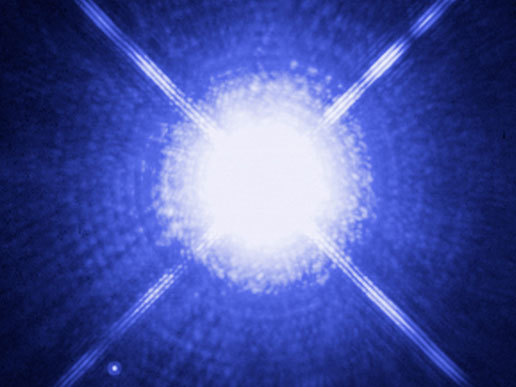News | March 27, 2011
Winter thaws out with hot exoplanet news

Despite the fact that white dwarfs, the dying remnants of stars, are very dim and only about the size of a planet, research suggests that Earth-like planets could exist around such stars.
(PLANETQUEST) -- Kepler's big annoucement of over 1,000 exoplanet candidates in early February continues to reverberate in the astronomy world. Here are some other news stories that are heating things up in the realm of exoplanets.
White dwarfs may have Earths, too
Could habitable, Earth-like planets exist around tiny, dying stars? Astronomer Eric Algol, of the University of Washington, thinks so. He recently published research showing that white dwarfs - cooling stars that have run out of nuclear fuel - could indeed harbor Earth-like planets. Such planets would be tidally locked, with one side permanently night and the other permanently day, and would orbit very close to their stars. Because white dwarfs are typically no bigger than the average terrestrial planet, Algol says that such worlds would be easy to spot with ground based telescopes. Read more...
Busy neighborhoodThe Milky Way may be packed with planets. Kepler Science Chief Bill Borucki says that the mission's latest results indicate that there are at least 50 billion planets in the Milky Way galaxy, with some 500 million in their host star's habitable zone. These figures were extrapolated from the Kepler mission's current haul of over 1,000 possible exoplanet discoveries. As the mission moves into its third year, scientists anticipate that Kepler will begin to discover planets with longer orbits similar to Earth's, which means that Kepler's greatest discoveries could be yet to come. Read more of Borucki's reflections on the Kepler mission here.
Appearances can be deceivingWhile Kepler is quickly racking up new exoplanet candidates for astronomers to study, the process of confirming and understanding these finds remains tricky. When Kepler released its list of candidates in early February, the candidate KOI 326.01 got a lot of attention for being one of the most Earth-like planets yet discovered, due to its size and the fact that it was the right distance from its star to have liquid water.
However, further research revealed that KOI 326.01 isn't quite as promising as previously thought. Discover Magazine fact-checkers found that KOI 326.01 may actually be orbiting one of two nearby stars, and that it's very likely that the planet is much larger and hotter than previously thought, a finding verified by the Kepler science team, which has warned scientists and the media against jumping to conclusions about unconfirmed exoplanet candidates. Read more...
Written by Joshua Rodriguez/PlanetQuest




